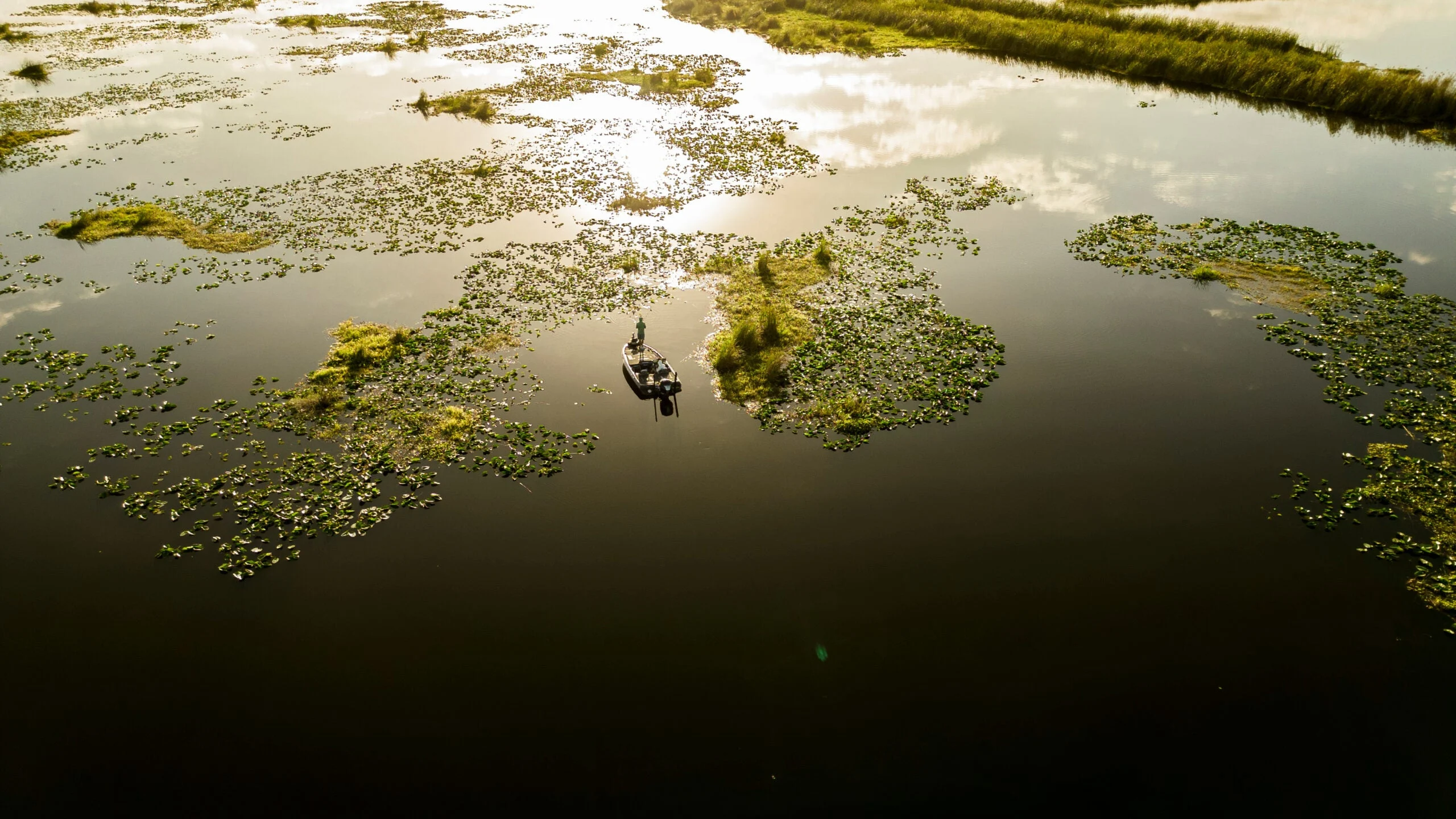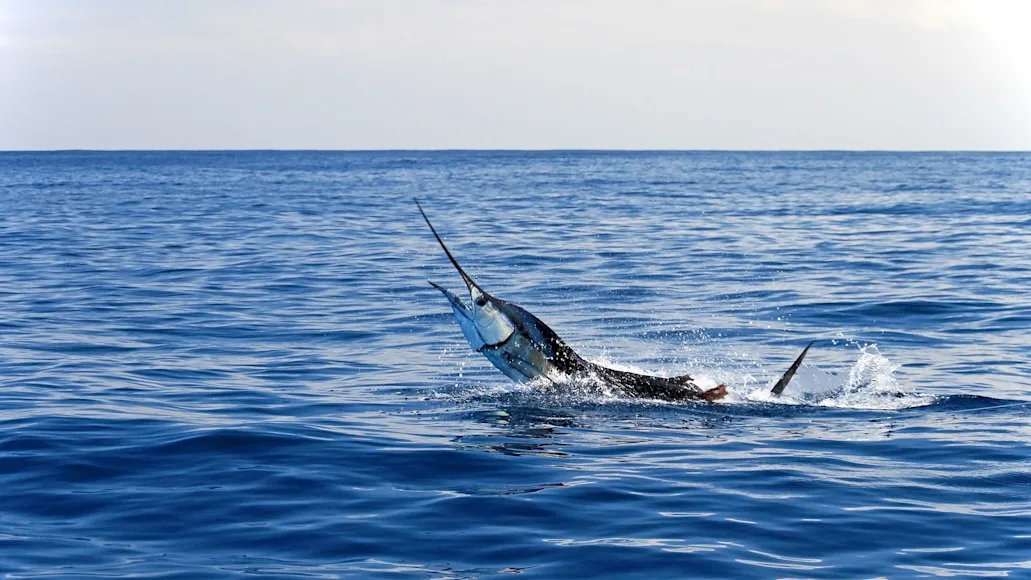The biggest challenge of creating a list of the best places to fish in Florida is whittling the numerous options down to a manageable group. We’re not trying to summarize the entire state; rather, the goal here is to offer a representative sampling of Sunshine State delights.
As with all lists, exclusion implies not disrespect, so save the hate mail. This roundup simply highlights some of Florida’s more notable destinations. Look an hour or so in either direction and you’ll likely find similar opportunities, so it you prefer a spot closer to home, book a charter or go solo to enjoy what you want to enjoy.
Best Places to Fish in Florida: Saltwater

1. Destin
Starting with the Florida Panhandle’s massive Choctawhatchee Bay—a major estuary fed by multiple rivers, creeks, and bayous—anglers find good numbers of speckled trout, redfish, black drum, sheepshead, striped bass, and Spanish mackerel. Here, seagrass beds, oyster mounds, sand bars, docks, the Choctawhatchee River Delta, and publicly accessible jetties offer something for every angler.
Where stunning beaches meet sparkling Gulf waters, the surf/coastal zone holds pompano, mackerel, bluefish, and whiting, tarpon, cobra, and sharks. Offshore reefs, wrecks and rocks are renowned for gag and red grouper, mangrove and red snapper, triggerfish, amberjack, kingfish, and Spanish mackerel. Run deep and you’ll find tuna, wahoo, dolphin, and billfish.
2. Homosassa
A mix of inshore faves—redfish, trout, snook, pompano—inhabit the countless rock islets and mangrove shorelines, while the St. Martins Keys north of the river channel offer a truly unique inshore look (mangroves, grass flats, limestone/sea fan bottom) in the offshore range.
Coastal waters littered with rock reefs offer arm-stretching, shallow-water (10-12 feet) grouper action, along with ample opportunities for Spanish mackerel, seabass, and sheepshead.
During the summer season, this is one of the hotspots for scallop diving. Culinary tip: Fresh scallops make a fine topping for grilled or blackened redfish.
3. Charlotte Harbor-Pine Island Sound
This mangrove-laden estuary fed primarily by the Myakka and Peace rivers holds a bounty of the inshore all-stars—snook, trout, redfish, flounder, and respectable mangrove snapper. Lots of oyster bars, mangrove creeks, and potholes define fish-friendly habitat.
Winter’s extreme low tides create a cool scenario where fish pile into the scattered deep water troughs and holes that become cut off by receding water. Snook, trout, and reds are easy pickings for waders and kayakers.
Owning the title “Tarpon Capital of the World,” Boca Grande Pass flows between Cayo Costa to the south and Gasparilla Island to the north. This is one of the best places to fish in Florida between May and June, as this window creates prime-time fishing for tugging on silver giants that pack into the pass prior to their offshore spawning run. Throughout the summer, tarpon schools offer tons of fun on the beaches, while nearshore reefs abound with grouper, snapper, hogfish, and permit.
The pass is a major flushing point with tons of bottom structure holding keeper gag grouper, mangrove snapper, and giant Goliath Grouper (particularly at the old phosphate docks on the north side). Smoker kingfish and hefty Spanish mackerel commonly venture well inside the pass.
You’ll find a similar species mix in the next major estuary to the north—Tampa Bay—but you’ll also find significantly more boat traffic and fishing pressure. Charlotte Harbor and Pine Island sound are hardly a secret, but Tampa Bay’s more developed region means more folks sharing the water.
4. Jacksonville
With the St. Johns River meeting the Atlantic through Mayport Inlet, expansive inshore marshes abound with redfish, flounder, black drum, sheepshead, and seatrout, while Huguenot Memorial Park (north side of the inlet) sees serious surf fishing action.
Coastal and offshore waters produce some of the region’s most impressive king mackerel action. Move inside, closer to the Jacksonville waterfront and the numerous residential waterways and you’ll find a mix of speckled trout, redfish, snook, tarpon, and striped bass keeping company with largemouth bass and channel catfish, depending on salinity levels.
5. Fort Pierce
With its namesake inlet separating North Hutchison Island from South Hutchison island, this historic destination offers access to numerous boating, kayaking and wade fishing hotspots in some of the Indian River Lagoon’s prime sea trout waters. And, not just any trout, as this area is known for giant “gator” trout in the 7- to 10-pound range. You gotta work for it, but trophy fish live here, as do big snook, pompano, and redfish.
Offshore waters see lots of big kingfish, African pompano, cobia, and sailfish. The latter swim here year-round, but October-January highlights Fort Pierce’s prominence as the top end of Florida’s famed Sailfish Alley, which runs south to Palm Beach.
6. Islamorada
Stretching 20 miles along the Overseas Highway (U.S. 1), Islamorada comprises four inhabited keys—Plantation, Windley, Upper Matecumbe (site of the original Islamorada village), Lower Matecumbe— and the offshore islands of Indian Key and Lignumvitae Key and the private Tea Table Key.
This South Florida gem uniquely blends family-friendly vacation fun with hardcore, briny-blooded angling ambiance. You won’t find a greater diversity of saltwater species in Florida water, and it all comes down to proximity.
To the north, Florida Bay and Everglades National Park hold a treasure trove of snook, trout, redfish, and tarpon. Moving west toward the open Gulf of Mexico brings permit, Spanish mackerel and a mix of wreck/reef species into play.
On the “ocean side,” the Islamorada flats are renowned bonefish territory, while permit, tarpon, barracuda, and sharks add to the fun. Within a mile or so of shore, the patch reefs offer a mix of grouper, snapper, porgies, and tropicals (especially in the fall and winter), while the deep blue water range holds tuna, dolphin, wahoo, kingfish, sailfish, marlin, and swordfish.
Additionally, the Islamorada bridge fishing is a world of its own. With the Channel 2 and Channel 5 bridges easily accessible, land-bound anglers tangle with snapper (mutton, mangrove, lane, yellowtail, and cubera), grouper (gag, Nassau, Goliath), tarpon, permit, cobia, and a bouquet of tropicals like doctorfish, parrotfish and puddingwife wrasse. When deciding where to fish in Florida on a budget, this one’s hard to beat.
Best Places to Fish in Florida: Freshwater

1. Lake Talquin
Located just west of Tallahassee, this 8,850-acre Ochlockonee River impoundment boasts a stellar crappie fishery that produced the state record 3.83-pounder (1992). Lean on grass, Talquin holds a lot of stumps and standing timber with greater depths than most Florida lakes (15-foot average, 45 max). Largemouth bass, striped bass, bluegill and redear sunfish complement the crappie.
2. Harris Chain of Lakes
Comprising eight lakes—Harris, Griffin, Eustis, Dora, Beauclair, Carlton, Apopka, and Yale—the chain covers approximately 75,000 acres. All but Yale link by rivers and canals.
Located north of Orlando, this diverse chain boasts all the major Florida bass habitat features, with lots of offshore grass beds and shell bars offering key staging areas for pre- and post-spawn fish. The entire chain holds tournament-friendly quantity and quality, but Lake Apopka historically yields the most impressive catches.
Notably, the Harris Chain creates the headwaters of the Ocklawaha River, which links northward to Rodman Reservoir, the timber-strewn wonderland with its own big-bass bona fides. Navigating through the Buckman Lock, and traversing the Rodman Canal leads into the St. Johns River, thereby offering oceanic connection from Central Florida.
3. Fellsmere Reservoir
Also known as Headwaters Lake, this 10,000-acre manmade fishery in Indian River County has become arguably the state’s top big-bass location. Taking what was once a large agricultural tract, the Florida Fish and Wildlife Conservation Commission worked alongside the St. Johns River Water Management District to reshape the area with an expansive habitat enhancements that complement the standing timber, hydrilla, cattails, and spatterdock. After flooding the area, the FWC stocked with nearly a million Florida strain largemouth, along with bluegill, redear sunfish and crappie.
4. Lake Okeechobee: Best Place to Fish in Florida for Big Bass
Florida’s largest lake has experienced its share of water management challenges, but this 730-square-mile big bass factory continues to crank out the quality and quantity. The sheer size, plus its rim canal, the Kissimmee River and major creeks give fish and fishermen plenty of room to spread out. A popular bass tournament favorite, Okeechobee’s also known for its crappie action. If you’re trying to find the best places to fish in Florida for bass, Okeechobee has to be considered.





